Cosmic Curiosities
“I have just gone over my comet computations again, and it is humiliating to perceive how very little more I know than I did seven years ago when I first did this kind of work.”
~ Maria Mitchell, 19th century American Astronomer
Sun and Moon Size -- A Coincidence?
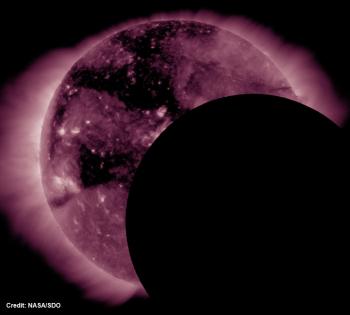 While explaining eclipses to Planetarium visitors, I get many curious looks when I tell them the Sun and Moon are the same size in the sky. When I clarify, “The Sun is 400 times bigger than the Moon, but…” they quickly finish my sentence with, “…the Moon is 400 times closer than the Sun!” And that is why our tiny Moon blocks the gigantic Sun and we witness amazing total solar eclipses!
While explaining eclipses to Planetarium visitors, I get many curious looks when I tell them the Sun and Moon are the same size in the sky. When I clarify, “The Sun is 400 times bigger than the Moon, but…” they quickly finish my sentence with, “…the Moon is 400 times closer than the Sun!” And that is why our tiny Moon blocks the gigantic Sun and we witness amazing total solar eclipses!
What are the odds of the Moon and Sun appearing nearly the same size from Earth? We don’t know. We just started discovering exoplanets around the distant stars in our galaxy -- almost 4,000 have been found so far. However, no one has discovered an exomoon yet, so we simply don’t know if there’s another moon out in the galaxy that barely casts its shadow onto its host planet. But with billions of stars in the Milky Way, and presumably billions of planets and moons, the odds are likely.
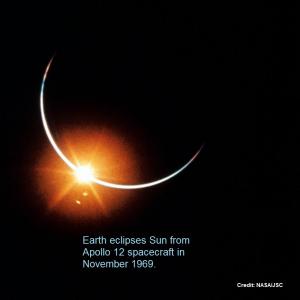 Are there other total solar eclipses in our solar system? Absolutely! If you were an astronaut on the Moon during a lunar eclipse on Earth, you would see a total solar eclipse from the lunar surface. And it would last over an hour—with no threat of clouds! :)
Are there other total solar eclipses in our solar system? Absolutely! If you were an astronaut on the Moon during a lunar eclipse on Earth, you would see a total solar eclipse from the lunar surface. And it would last over an hour—with no threat of clouds! :)
On November 21, 1969, the three Apollo 12 astronauts -- Pete Conrad, Dick Gordon, and Alan Bean -- experienced a solar eclipse from space. They were heading home after a successful lunar landing when they saw our planet start to cover up the last rays of the Sun before all sunlight completely disappeared behind the Earth’s dark disc.
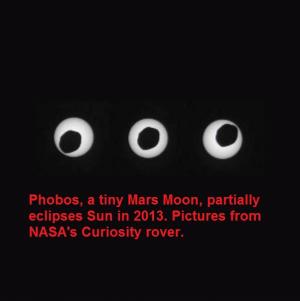 Mars has two potato-shaped moons but they are so small, they would not fully eclipse the Sun. In 2013, NASA caught a partial eclipse on the red planet thanks to the Curiosity rover. Mercury and Venus have no moons, so no eclipses are possible there.
Mars has two potato-shaped moons but they are so small, they would not fully eclipse the Sun. In 2013, NASA caught a partial eclipse on the red planet thanks to the Curiosity rover. Mercury and Venus have no moons, so no eclipses are possible there.
Not that anyone could live on a gas planet surface, but Jupiter, Saturn, Uranus, and Neptune all have total solar eclipses. They have many substantially-sized moons that can block the Sun's light, and the Sun is much smaller in the outer solar system. Pluto’s large Charon can eclipse the Sun, too!
If that Sun-and-Moon “400” ratio still seems a strange coincidence, please note they rarely shine the exact same size in the sky. Both the Earth's and Moon's orbits are elliptical, not perfect circles. This causes the Sun and Moon apparent sizes to vary a bit. You may have heard of the “supermoon” -- this is when the Moon is about seven percent closer to Earth and appears a tiny bit bigger, but it’s hardly noticeable. These size variances cause total solar eclipses to last anywhere from a few seconds to up to seven and a half minutes. On August 21, the greatest eclipse time will be two minutes and 40 seconds.
Comet Craving
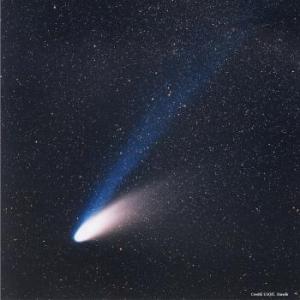 I recall 20 years ago spotting Comet Hale-Bopp from downtown Minneapolis. I had been working late at the Planetarium, planning telescope viewing-nights for this cosmic interloper. I was amazed you could see the comet even with the surrounding city lights. It looked like a faint, fuzzy teardrop-shaped star. Of course, we had much better views in darker locations and with telescopes, but to see a bright comet among all the streelights was captivating.
I recall 20 years ago spotting Comet Hale-Bopp from downtown Minneapolis. I had been working late at the Planetarium, planning telescope viewing-nights for this cosmic interloper. I was amazed you could see the comet even with the surrounding city lights. It looked like a faint, fuzzy teardrop-shaped star. Of course, we had much better views in darker locations and with telescopes, but to see a bright comet among all the streelights was captivating.
Comets are small icy boulders ranging in size from a football stadium to miles across. They have been called “dirty snowballs.” (But since they are much bigger than a snowball, maybe “dirty glacier” or “dirty iceberg” would be a better moniker!)
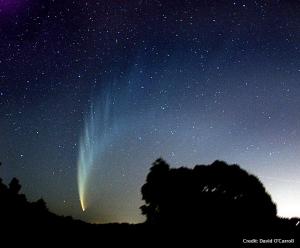 We northerners have not seen a bright comet since those clear March and April nights back in 1997. Southern hemisphere viewers have had two bright comets — Comet McNaught in 2007 and Comet Lovejoy in 2011 — to gaze upon and photograph. Speaking of all those lovely images of comets, please note these are taken by talented photographers that often use telescopes or long exposures—or both. Almost all of these stunning portraits are not what you see with the human eye.
We northerners have not seen a bright comet since those clear March and April nights back in 1997. Southern hemisphere viewers have had two bright comets — Comet McNaught in 2007 and Comet Lovejoy in 2011 — to gaze upon and photograph. Speaking of all those lovely images of comets, please note these are taken by talented photographers that often use telescopes or long exposures—or both. Almost all of these stunning portraits are not what you see with the human eye.
There have been many teasers since Comet Hale-Bopp. In March 2013, Comet PanStarrs could be observed, but was pretty dim and took a lot of effort. It was not a solar system sight that an average stargazer could just look up and see. For the serious comet-hunter, though, it was a spectacular display to behold and image with a sophisticated camera.
Are we overdue for a bright comet? Perhaps, but in 1996, another bright comet was easily visible from the city—Comet Hyakutake. Two comets in a row! Comet-fever was at hand, especially after Halley’s Comet wasn’t all that spectacular in 1986.
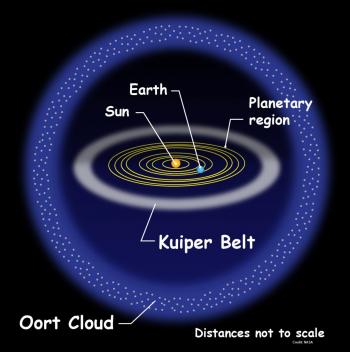 This July, you may hear about Comet Johnson, but do not expect to easily see this icy rock in the sky. It might reach naked eye visibility, but only if you’re in very dark skies. It will be another teaser as we anxiously await another bright comet to grace our skies.
This July, you may hear about Comet Johnson, but do not expect to easily see this icy rock in the sky. It might reach naked eye visibility, but only if you’re in very dark skies. It will be another teaser as we anxiously await another bright comet to grace our skies.
Comets come around all the time as they orbit the Sun. According to NASA, there are billions of comets located in the Oort cloud, a sphere of icy debris located in the far reaches of the solar system. There are about 4,000 comets that have been discovered, with new ones added every year!
Sky Sights
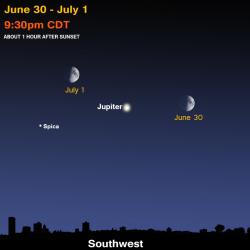
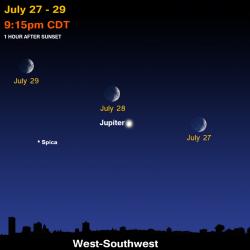
Jupiter and the Moon have two great conjunctions this July—at the beginning and near the end of the month. The mighty king planet will be around all summer, shining near the bright star Spica in the constellation Virgo. Starting in late September, Jupiter gets tougher to see as it sets shortly after the Sun goes down. Don’t forget to check out the stunning new images of Jupiter from NASA’s Juno spacecraft.
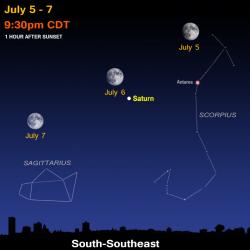
Saturn is now visible right after sunset in the southeast. On July 6, the ring jewel will shine just below the Moon, but look for the night before and after. Saturn's rings are great through a telescope so visit a “star party” hosted by your local astronomy club. They are free events, and the amateur astronomers are always delighted to show Saturn's beauty through one of their ‘scopes.
Mars is located to near the Sun’s bright rays and is not visible all month.
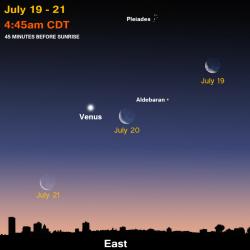
Venus is unmistakable in the morning sky. Get up early before 5:00 a.m. to see the brightest planet low in the eastern sky. Look for the Moon shining nearby on July 19-21.
Mercury is too difficult to see all month.
Star Map
 Download the July Star Map.
Download the July Star Map.
Sign Up
See the Universe through a telescope! Join one of the Milwaukee-area astronomy clubs and spot craters on the Moon, the rings of Saturn, the moons of Jupiter, and much more.
Send an e-mail to Planetarium Director Bob Bonadurer at bonadurer@mpm.edu and place 'subscribe' in the subject line to receive the Starry Messenger and monthly star map.
![]() Follow Bob on Twitter @MPMPlanetarium.
Follow Bob on Twitter @MPMPlanetarium.

